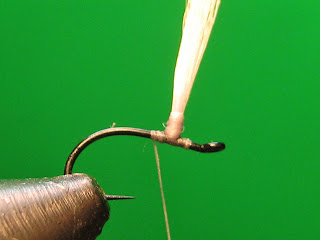Hook - Thin wire dry fly hook. I'm using a TMC 206BL size #18
Thread - Gray 8/0 UNI-thread
Parachute wing - I'm using dun colored Hi-Float fibers, but antron yarn, calf tail, etc. can also be used.
Hackle - Medium dun hackle one size larger than your hook.
Body - BWO dubbing with an extended mayfly body shown HERE.
Put your hook in your vise and start your thread.
Tie in some parachute wing material.
Stand up your parachute, and build a post with your thread.
Get your parachute exactly where you want it, and put a drop of head cement on the post to hold it in place.
 Tie in your hackle (shiny/convex side facing you) with a few wraps around the feather base, and the hook shank.
Tie in your hackle (shiny/convex side facing you) with a few wraps around the feather base, and the hook shank.I always trim the fibers from the bottom of the feather instead of stripping. It stops the feather from rotating.

Wrap your thread around the feather, and the post tightly.
This will hold your feather straight up and down as shown.
 Tie in your extended body about an eye's length behind the parachute post.
Tie in your extended body about an eye's length behind the parachute post. Trim the butt end of the body, and tightly secure your thread over the section you just trimmed.
Trim the butt end of the body, and tightly secure your thread over the section you just trimmed.You can apply Zap-a-Gap to the tie in point if you like, but if you secure it tightly enough, the body shouldn't rotate at all.

Put a little dubbing on your thread, and blend the extended body up to the parachute post.
Put your thread just in front of the parachute post.
Wrap 3-4 wraps of hackle around the parachute post.
Tie off your hackle against the hook shank.

Put some dubbing on your thread, preen back the hackle fibers, and wrap your dubbed thread to build the head of your fly.
 Whip finish and trim your thread.
Whip finish and trim your thread.I color my thread with an olive Sharpie marker.
Trim your parachute wing.




















